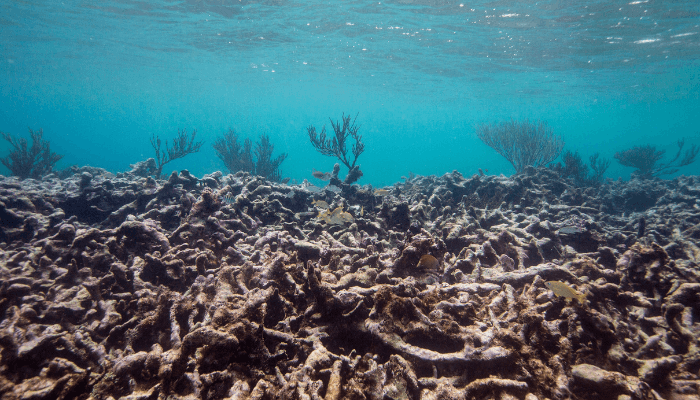What are the Creepy “Dead Zones” of the Oceans?
Ocean dead zones are those parts at the bottom of the ocean with low oxygen levels and no dissolved oxygen left for marine creatures to live. Over the past few years, ocean dead zones worldwide have increased, and many marine animals have lost their lives.
They are often called ‘biological deserts’, and though hypoxic zones are created naturally, they are enhanced due to human activity. Many physical, chemical and biological reasons act together to form such dead zones in the oceans. However, nutrient pollution is the biggest factor.
Excessive nutrients released from land or dumped as waste into rivers, coasts and streams lead to the growth of harmful algae, which then spreads, sinks and decomposes in the water. The decomposition process absorbs oxygen, and marine life is deprived of this much-needed oxygen. Eutrophication leads to Red tides or harmful algal blooms that kill fish, cause illness due to shellfish poisoning and death of marine mammals and birds.
Algal Blooms increase the productivity of aquatic ecosystems, resulting in rapid growth and proliferation of phytoplankton, algae, and seaweeds on the water’s surface. Algal blooms form dead zones beneath them, preventing light from penetrating the water’s surface. They also prevent oxygen from being absorbed by organisms living in the deep waters.
Dead zones stretch hundreds of square miles and are present in many coastal areas and the Great Lakes region. Human activities generate double the nitrogen and phosphorus than natural processes. Their level also depends on the country under consideration and its level of development.
For instance, in developed nations like the United States and the European Union Countries, excessive use of animal manure and commercial fertilizers in agriculture leads to eutrophication as runoff from fields flows into bays and creeks due to rains. In the developing nations of Latin and South America, Africa and Asia, usually, the culprit is untreated wastewater from sewage and industries. In some parts of the world, atmospheric nitrogen is also the cause.
According to Bob Diaz and Rutger Rosenberg, researchers from the Virginia Institute of Marine Science, the number of ocean dead zones increased between 1995-2007. They are counted as one of the environmental problems, along with climate change, overfishing, habitat loss and harmful algal blooms. According to their findings, there are 405 dead zones in coastal waters worldwide, spanning over 95000 square miles. One of the largest dead zones is in the US.
Dead Zones are also found near the coasts of Virginia and Oregon. However, they can be reversed if their causes are minimised and eliminated. For instance, an expansive dead zone in the Black Sea disappeared in the 1990s after the collapse of the Soviet Union. This happened due to the rise in the price of chemical fertilisers, which reduced their use.
Today, scientists, the United Nations and policymakers are trying to reduce the emissions in regions where dead zones pose a serious issue to the marine ecosystem. Some countries along the river Rhine have successfully decreased the nitrogen levels in the waters, and the dead zone in the North Sea is shrinking.
Prominent Ocean Dead Zones
The biggest dead zone is found in the Baltic Sea due to the overfishing of the baltic cod. Cod consumes sprats, a herring-like species that eats microscopic zooplankton that eats the algae. However, since the number of cod has reduced, there has been an increase in the number of sprats and zooplankton, which means more algae and hypoxia or low oxygen in the waters.
The northern gulf of Mexico is the second largest dead zone, close to the Mississippi river. In 2002, it covered 8500 square miles, the same size as the state of Massachusetts. The Chesapeake Bay also has a dead zone which occupies forty per cent of the Bay area and five per cent of its volume, stretching from the harbour of Baltimore into the waters of Virginia. The first dead zone was formed in the 1920s and has grown and expanded.
Over the past few years, ocean dead zones have increased considerably. The process, which to some extent occurs naturally, has been hastened by excessive use of fertilisers and other products costly to marine creatures’ lives these past few years.
Hence, the Black Sea, the Mississippi River, and the Yangtze River are some of the few areas where ocean dead zones have started to increase. In these areas, due to the reasons mentioned above, the natural habitat of marine creatures breeding in these waters has begun to get hampered. Of course, it has to be said that the animals that get affected do look out for other areas in the ocean to breed and continue with their survival; the widening of the extent of the sea dead zones has started to encroach upon the alternate survival areas as well.
For most of us, marine products are essential in our basic diet. This being the case, the widespread mutation of the unwanted algae costs marine life and human interests. Therefore it becomes very important that we start to look for ways to find alternative sources for dumping sewage and fertilisers.
As much as we depend on oxygen for survival and agriculture for our food, marine animals also depend on oxygen in the water. Therefore it would be completely wrong on our part to deprive them of their life when we can think of helpful alternative solutions to simplify and enhance our life.
Frequently Asked Questions
1. What are Ocean Dead Zones?
Ocean dead zones are those parts at the bottom of the ocean with low oxygen levels and no dissolved oxygen left for marine creatures to live. They are also called biological deserts by scientists and experts.
2. What leads to the formation of such zones in the oceans?
In developed nations, excessive use of animal manure and commercial fertilizers in agriculture leads to eutrophication as runoff from fields flows into bays and creeks due to rains. In the developing nations of Latin and South America, Africa and Asia, usually, the culprit is untreated wastewater from sewage and industries. In some parts of the world, atmospheric nitrogen is also the cause.
3. Can the Dead Zones become lively again?
Dead Zones can be reversed if their causes are minimised and eliminated. For instance, a giant dead zone in the Black Sea disappeared after the Soviet Union collapsed, and the prices of chemical fertilisers rocketed, which decreased their use.
4. How long do dead zones take to recover?
The latest study has highlighted that even if all the nitrogen runoff were completely eliminated, it would take at least three decades for an ocean dead zone to recover and flourish.
5. Are the dead zones getting bigger?
The Gulf Of Mexico dead zone spans 6334 square miles; however, it is continuously increasing. Per reports, the 2021 zone is larger than the average measured over the last five years.
You might also like to read-
- What Does the Term “Ocean Biome” Means ?
- Gulf Of Mexico Dead Zone In Need Of Bold New Approaches
- Ocean Pollution – 6 Things That Make It Worse
- The Mystery of the Dead Sea Scrolls
- Understanding Thermoclines In Ocean Waters
Disclaimer: The authors’ views expressed in this article do not necessarily reflect the views of Marine Insight. Data and charts, if used, in the article have been sourced from available information and have not been authenticated by any statutory authority. The author and Marine Insight do not claim it to be accurate nor accept any responsibility for the same. The views constitute only the opinions and do not constitute any guidelines or recommendations on any course of action to be followed by the reader.
The article or images cannot be reproduced, copied, shared, or used in any form without the permission of the author and Marine Insight.

About Author
Raunek Kantharia is a marine engineer turned maritime writer and entrepreneur. After a brief stint at the sea, he founded Marine Insight in 2010. Apart from managing Marine Insight, he also writes for a number of maritime magazines and websites.
Do you have info to share with us ? Suggest a correction
Subscribe To Our Newsletters
By subscribing, you agree to our Privacy Policy and may receive occasional deal communications; you can unsubscribe anytime.
Web Stories









